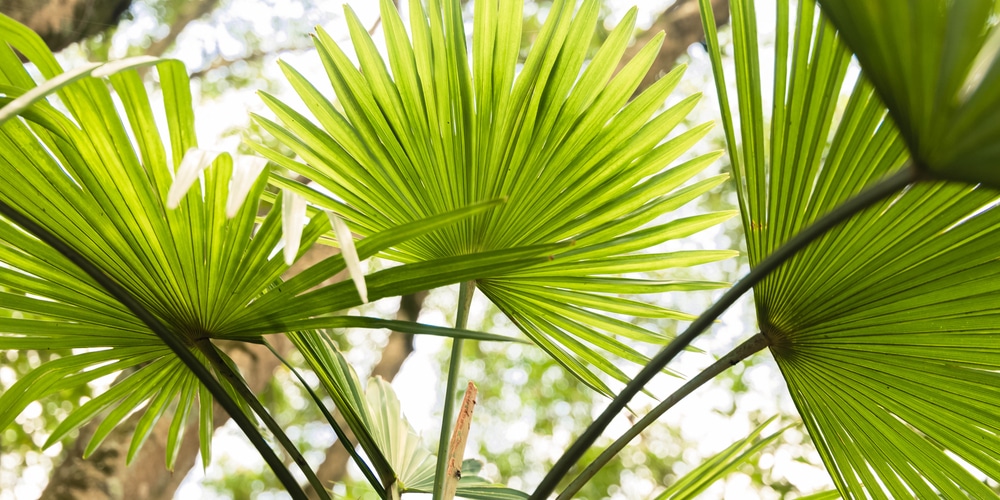Popular for its appearance and long life, the Chinese Fan Palm is a very suitable houseplant. It also goes by the name Fountain Palm because of its fronds that are like water cascading from a fountain.
This palm is native to Asia, especially the Eastern parts such as China, Japan, and Taiwan. It is known to be slow-growing but relatively hardy which makes them ideal plants for beginners. They can be grown indoors and outdoors, and they make excellent houseplants because they can tolerate low light.
| Botanical Name | Livistona chinensis |
| Common Name | Chinese Fan Palm, Fountain Palm |
| Plant Type | Perennial or Annual |
| Flower Color | Cream |
| Size When Mature | 360-600 Inches |
| Bloom Time | Spring |
| Sun Requirements | Full to Partial Sun |
| USDA Hardiness Zones | 9-11 |
| Soil PH Range | 6.0-8.0 |
| Soil Type | Loamy, moist, well-draining |
| Water Needs | Low |
| Native Area | Asia, especially China, Japan, and Taiwan |
What You Need to Know About Chinese Fan Palm
When still young, the fronds are green in color that will eventually turn grayish-brown. It grows upright with its fronds arching up and then its ends drooping mimicking what water from a fountain looks like.
Though this palm does not grow quickly, its fronds can surprisingly grow up to 60 inches. It blooms very tiny white flowers during spring that hides among the leaves. These flowers will eventually turn into blue to black fruits that look similar to black olives.
Most importantly, this palm is non-toxic and very safe, both for humans and animals. Caring for this plant is not difficult as long as you know the basic needs. It does not require too much maintenance and can tolerate neglect.
How to Care for Chinese Fan Palm
Here’s everything you need to know about growing and caring for a thriving Chinese Fan Palm:
Light
Chinese Fan Palms are known to be tolerant of a wide range of light conditions. They can be placed in direct sunlight or in shaded areas. However, they will grow best in bright, direct sunlight for at least six to eight hours per day.
If you are growing your palm indoors, place it near a window where it will get plenty of indirect light. Also, for young palms, it would be best to keep them in shade.
Water and Soil Needs
When it comes to watering, the Chinese Fan Palm is not too fussy. These palms are drought-tolerant but watering them during hot days is essential. Just be careful not to overwater as this can cause root rot and other diseases which may eventually kill the plant.
It is also important to make sure that the pot has good drainage to avoid waterlogged soil. It prefers well-drained soil and will thrive in loamy, moist soil with a pH of 6.0 to 8.0, just like most species of palm.
Temperature Requirements
Chinese Fan Palms like warm temperatures and humid conditions. They can tolerate cold temperatures and are resilient to cold and frost but will still likely have their foliage damaged. They should be able to survive in USDA zones 9-11.
Fertilizer
The best fertilizer to use on a Chinese Fan Palm is a slow-release fertilizer with a ratio of 8-2-12. Though not needed, feeding your plant will encourage faster growth since it is slow growing. You may fertilize your palm twice or thrice a year during its growing season.
Common Diseases
This palm has no major pest and disease problems but is susceptible to scale infestation, spider mites, ganoderma butt rot, and lethal yellowing disease.
Scale infestation is very common with palms and this insect sucks on the sap of the plant which can cause yellowing and wilting of the leaves. They would stick themselves to the stems, leaves, and branches of the plant. To get rid of these pests, you may use horticultural oil or insecticidal soap and spray it on the plant. Pruning the infected parts is only applicable if the infestation is still in its early stages.
Spider mites are also common pests that attack palms. These tiny creatures are difficult to see with the naked eye but they can cause a lot of damage to the plant. They suck on the sap of the leaves which can cause them to turn yellow, brown, and eventually die. You may get rid of them by spraying pressurized water on your plant regularly or using horticultural oil or insecticidal soap. You can also use neem oil if you opt to use a more natural solution.
All palms are susceptible to Ganoderma butt rot. It is a disease that starts on the trunk of the palm and can eventually kill the plant. Unfortunately, once infected, there is nothing else you can do to save your plant.
Lethal yellowing disease is a fatal disease that attacks many species of palms including the Chinese Fan Palm. It would show symptoms similar to Ganoderma butt rot. Just like the previously mentioned disease, there is no cure for this disease either and infected palms must be removed to prevent the spread of the disease.
Chinese Fan Palm Propagation
Propagation is usually done by sowing seeds. The seeds should be sown in a well-drained potting mix and should be kept moist. Once germination occurs, which takes about two months. In using cuttings to propagate, look for a sucker and use a sharp knife to cut it from the parent plant. Cuttings should be about 11 inches long.
Related Article: Are Palm Trees Native to California?

